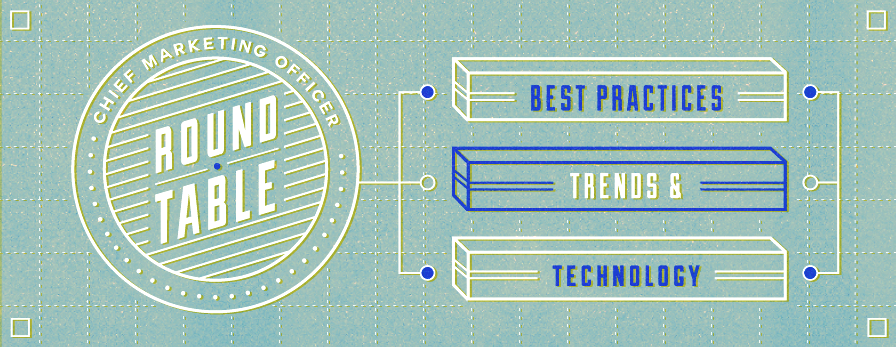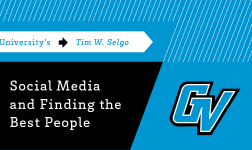In the fast-paced world of college athletics marketing—where the sophistication of promotion is continually increasing, evolving, and growing more refined—chief marketing officers are always on the hunt for keener insight into the needs of their audience. 1 Four of the industry’s best (Craig Pintens – University of Oregon, Teri Pierce – University of Texas Austin, Mike Hill – University of Florida, and Eric Nichols – University of South Carolina) were good enough to answer a few questions for Winthrop Intelligence about their current innovations and expectations for the future.
Can you site a few specific examples of how technology has impacted your role in recent years? 2
 Craig Pintens – University of Oregon
Craig Pintens – University of Oregon
Senior Associate Athletic Director/Marketing & Public Relations
Technology has changed everything. Smart phones and tablets have made it much easier for everyone to stay connected. With that, the pace remains constant which is a good thing. The rise of social media has changed the parameters of the position tremendously and provided us with a great opportunity to promote our brand. With new social mediums popping up, it is important to remain on top of technology. It seems as if we are reading a lot more technology blogs to make sure we don’t miss out on anything.
 Teri Pierce – University of Texas
Teri Pierce – University of Texas
Associate Athletic Director, Marketing
a. Ticketing systems. Ex. We can use technology to add-on amenities during the ticket purchase process; use social media during the ticketing process; message folks during the ticketing process—upsell, or give information pertinent to their ticket purchase. There are also opportunities for ticket systemadd-ons that can allow for things like dynamic ticket pricing and data crunching.
b. Scanners. Check-ins for our student rewards program are now done on unmanned stations that have ipads with scanners. This creates a more efficient experience for students checking in and saves us on staffing costs. Hand scanners also allow us to move folks into our venues more quickly, provide us with more efficient reporting, and fewer ticket fraud issues.
c. Advances in digital media (primarily social and mobile), allow us to target more audiences and more narrow audiences, and then reach them in real time. Where no-cost mass messaging used to be more of a function of media relations/SID, these advances open the door for marketing to use these channels for outreach. Additionally, we now have the ability to measure our efforts like never before. The challenge is finding ways to consistently and efficiently narrow, code and monitor these metrics.
 Mike Hill – University of Florida
Mike Hill – University of Florida
Executive Associate Athletics; Director for External Affairs
Technology has made an enormous impact on so many facets of our operation. The evolution of the mobile phone and how it is used by the masses has changed the way we market. From mobile apps, to texting, to ease of uploading video and photo content, the mobile phone is an indispensable tool for fans and also allows for a more efficient method of targeting communication to those fans. The increasing popularity of tablets has also changed how fans consume content.
Certainly, the explosion in social and new media has provided new, highly effective avenues for us as well. Our approach has been completely revolutionized by technology, especially in the past five years. HD technology has provided a more enjoyable in-stadium video board presentation, but it also created serious competition at home with big-screen, HD televisions in so many households.
 Eric Nichols – University of South Carolina
Eric Nichols – University of South Carolina
Assistant AD/Marketing
My entry into the Marketing world was through the digital media path, so I have an extensive background in database marketing and web design. With the introduction of social media, and the tool-of-the-day environment that is the digital space, I have been able to position myself into the technology role and charged with figuring out how to use them to accomplish our departmental goals. When the iPads penetrated the market over the past year, we had IT guys on staff to tell the department how they work, and my role was to leverage their capacity into a competitive advantage.
Describe one critical characteristic of a successful CMO?
 Craig Pintens – University of Oregon
Craig Pintens – University of Oregon
Senior Associate Athletic Director/Marketing & Public Relations
Passion. If you are passionate about the brand you are promoting, you will do everything in your power to make sure your brand remains strong.
 Teri Pierce – University of Texas
Teri Pierce – University of Texas
Associate Athletic Director, Marketing
A successful marketing person must have energy, be industrious, and ever curious. They must always ask how things work, how things can get better, and how can things realistically, get done. The role might not be a fit for someone who is looking to settle into a routine, or get too comfortable in their position. CMOs must have the same competitive soul as coaches.
 Mike Hill – University of Florida
Mike Hill – University of Florida
Executive Associate Athletics; Director for External Affairs
A successful CMO has to pay attention. Listen, watch, read, discuss, and experience the trends in athletics marketing so that you have an awareness of today’s solutions. It’s a daunting task, because the changes never end, but you’ll be left behind if you aren’t in tune with what is happening around you. In short, the best CMOs understand how important it is to communicate well and be observant of emerging trends, or else their organization risks falling behind in a significant way.
 Eric Nichols – University of South Carolina
Eric Nichols – University of South Carolina
Assistant AD/Marketing
Probably more so than any other position short of an Athletics Director, a successful CMO has the ability to relate and manage a broad spectrum of personalities. The ability to motivate staff, many of which do not report to you, to a common goal is critical to success. Constituents include sidewalk fans, media, top donors, University administration and Board of Trust, 23 year old entry level staff, and of course our coaches.
What is the next big trend you see in college athletics marketing, and how are you preparing for it?
 Craig Pintens – University of Oregon
Craig Pintens – University of Oregon
Senior Associate Athletic Director/Marketing & Public Relations
Well, I really wish there was a crystal ball to predict the next big trend. You will continue to see schools try and engage more with their fans. We are in competition for their disposable income dollars and we must do everything in our power to capture that revenue. Hopefully there will be more schools spending time and money on research as it is a very underutilized marketing weapon in college athletics.
Social media will continue to be a trend, the danger is trying to overcommercialize it in hopes of monetization. Social media is about engagement with your fans. If you engage, there is long-term ROI benefits. Choosing metrics to measure social media effectiveness is going to be key for us moving forward.
 Teri Pierce – University of Texas
Teri Pierce – University of Texas
Associate Athletic Director, Marketing
a. I believe mobile devices will overtake computers in the “fan space.” We need to look at creative and fiscally responsible ways to reach fans on mobile platforms. I believe more organizations will adopt a flexible web design, such as responsive web design (RWD). This will cause us all to revisit our iphone and android app strategies and potentially force those of us in sports to use data to prioritize the information immediately visible and accessible on mobile devices.
b. With the proliferation of television networks and viewing options (multiple matchups at once, HD, 3d, etc.), and a teetering economy, I believe we will need to put an unprecedented focus on the customer and their experience. We will need to push the envelope regarding outreach and providing experiences that give people reasons to continue to purchase tickets and come to our venues to watch games in person.
c. While it seems like a contradiction, I think there will be a shift from a current (hyper) focus on technology, to one that is more balanced—that is, one that can use the technology as the means of dealing with, contacting and reaching out to humans. I think there will be more focus on a human touch and interaction as a means of acquiring and growing the fan base. This can, but won’t necessarily, be accomplished exclusively through technology.
 Mike Hill – University of Florida
Mike Hill – University of Florida
Executive Associate Athletics; Director for External Affairs
Interactive marketing through social media. It is what is increasingly driving successful campaigns and will continue to grow. As the use of social and new media tools continues to skyrocket, traditional media buys will shrink, with the notable exception of advertising within live televised sports, the most consistent and devoted reality TV following there is. Customers are becoming part of campaigns now, actively participating rather than simply being targeted with advertising. One of the keys is to engage them rather than blasting the message at the consumer.
 Eric Nichols – University of South Carolina
Eric Nichols – University of South Carolina
Assistant AD/Marketing
I think the next big trend in college athletics marketing is what some refer to as “big data.” With the explosion of digital marketing and social media, there is more data available than ever before. The next trend will be in best practices and tools to collect, analyze, and monetize the numerous data points that are now at our fingertips.
Discuss how difficult economic conditions altered / impacted 3 your marketing strategy in recent years?
 Craig Pintens – University of Oregon
Craig Pintens – University of Oregon
Senior Associate Athletic Director/Marketing & Public Relations
Economic conditions do affect strategies if you do not provide full-menu marketing. If you provide enough options (full-menu marketing) you will be able to overcome economic conditions. Make sure that you have something at different price points because retention is far more important than new sales.
 Teri Pierce – University of Texas
Teri Pierce – University of Texas
Associate Athletic Director, Marketing
We’re continually attempting to do something for little or nothing. We have the benefit of a great staff and it’s just a matter of using that human capital to achieve our goals, without a big outlay of cash. In this regard we always use:
a. Cross promotion (often with football).
b. Use digital assets for outreach, as opposed to paid advertising (again, human capital—don’t give away valuable revenue).
c. Maximize the use of technology, wherever possible, to reduce costs (and maximize returns).
 Mike Hill – University of Florida
Mike Hill – University of Florida
Executive Associate Athletics; Director for External Affairs
Fortunately, our ability to successfully market our product has become more inexpensive during this difficult economic period. We are able to use so many electronic communications at our disposal and have done so with great success. We see a phase-out of many print materials that were once considered sacred marketing tools. And by shifting our approach, our message is actually far more efficiently delivered than it once was.
Of course, the tough economy has also impacted our overall business, as all collegiate and professional teams have experienced. Ticket sales are not as strong as they once were, as we now compete with HD television at home as well as the secondary ticket market. And opponents’ fans are not traveling to football games as well as they used to, which often means that we have thousands more tickets to move before game day, and in a very soft market. Because of this, we have had to develop far more aggressive strategies than in the past.
 Eric Nichols – University of South Carolina
Eric Nichols – University of South Carolina
Assistant AD/Marketing
The state of South Carolina was hit brutally hard by the economic downturn in 2008. I think the seat inventory it made available for our football program fast-tracked a few initiatives, such as an internal sales staff. We have had good success using a Summer Sales Academy model where we professionally train a team of upperclassmen undergraduates and graduate students who are interested in a career in sports. This program has really moved the needle for our football program.
Name one recent innovative marketing initiative you have implemented, and discuss the impact it’s had?
 Craig Pintens – University of Oregon
Craig Pintens – University of Oregon
Senior Associate Athletic Director/Marketing & Public Relations
By the time this is published we will have launched the QuackCave, which is our social media command center. We were able to find an unoccupied space and arm it with a wall of flat screens controlled by iPads and wireless keyboards.
We will have a hand picked group of digital natives (UO students) that will monitor, produce and push content through all of our social media platforms. It will have a tremendous impact for us. We want to be “the” national brand in college athletics and this is an important step toward achieving that goal.
 Teri Pierce – University of Texas Associate Athletic Director, Marketing
Teri Pierce – University of Texas Associate Athletic Director, Marketing
Many schools are moving toward outsourcing outbound ticket sales. My feeling is that we have the internal expertise for our own outbound sales team—it needs only to be harnessed and coordinated. So, while it’s still a work in progress, I am working with a cross unit team to move our existing group/promotional sales team to a true, internal outbound sales team. This requires the collaboration of folks on our development staff, our ticket staff, and our promotional sales staff.
 Mike Hill – University of Florida
Mike Hill – University of Florida
Executive Associate Athletics; Director for External Affairs
Despite the national trend of declining season ticket sales, when faced with our own football season ticket deficit this year as compared to 2011, we developed a campaign called, “Live Life in The Swamp,” which primarily utilized social media (we have over 1.5 million followers between Facebook and Twitter) and video to subtly remind fans why there is nothing like the in-person experience at Florida Field versus staying at home.
In concert with the campaign, we saw a late surge in sales that pushed us past last year’s numbers and allowed us to re-engage former ticket holders as well as find new ones. While we were optimistic that the effort would produce results, we were astounded at the eventual success rate and plan to extend the concept into other sports including men’s basketball.
 Eric Nichols – University of South Carolina
Eric Nichols – University of South Carolina
Assistant AD/Marketing
While I am not sure it qualifies as innovation, the development and implementation of a written social and digital media strategy has been successful at South Carolina. Social media is like the Wild West, with everyone doing their own things, breaking their own news, and not speaking with a central message. We have spent the summer fine tuning our philosophies and best practices to guide not only the current mediums, but those that are bound to be launched next.
References:
- http://dupress.com/articles/from-mad-man-to-superwoman-the-legitimization-of-the-chief-marketing-officer/?coll=1158 ↩
- http://frontrow.espn.go.com/2012/12/espns-digital-media-metrics-are-you-engaged-or-just-clicking/ ↩
- http://espn.go.com/college-football/story/_/id/8727692/texas-aggies-start-marketing-blitz-johnny-manziel ↩




